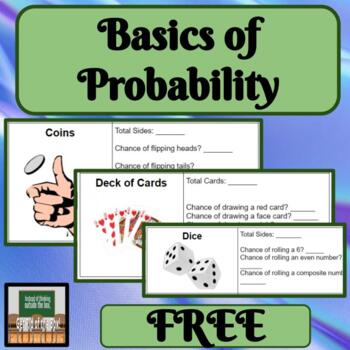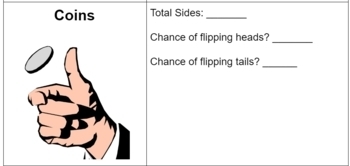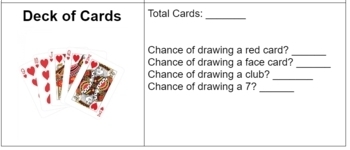Get Rid of the Box
793 Followers
Grade Levels
6th - 9th
Subjects
Resource Type
Standards
CCSS7.SP.C.5
CCSS7.SP.C.6
Formats Included
- Word Document File
Pages
1 page
Get Rid of the Box
793 Followers
Also included in
- About this Resource:This bundle includes activities/lessons for uniform versus non-uniform, probability lesson, hands-on, digital interactive notebook, and the basics. ALL OF THESE PRODUCTS AT A 30% DISCOUNT!✓ Teacher Tested✓ Student Approved*This product has been used in my cPrice $10.50Original Price $14.00Save $3.50
Description
About this Resource:
Many students do not know all that is needed about dice, coins, and decks of cards. In order to be successful, it is important to cover all of this information first.
Topic Covered:
*Probability
Ways to use this product in your classroom:
-whole class
-exploration
-hands-on
-small group
-independent
Other products with similar content.
Total Pages
1 page
Answer Key
N/A
Teaching Duration
N/A
Report this resource to TPT
Reported resources will be reviewed by our team. Report this resource to let us know if this resource violates TPT’s content guidelines.
Standards
to see state-specific standards (only available in the US).
CCSS7.SP.C.5
Understand that the probability of a chance event is a number between 0 and 1 that expresses the likelihood of the event occurring. Larger numbers indicate greater likelihood. A probability near 0 indicates an unlikely event, a probability around 1/2 indicates an event that is neither unlikely nor likely, and a probability near 1 indicates a likely event.
CCSS7.SP.C.6
Approximate the probability of a chance event by collecting data on the chance process that produces it and observing its long-run relative frequency, and predict the approximate relative frequency given the probability. For example, when rolling a number cube 600 times, predict that a 3 or 6 would be rolled roughly 200 times, but probably not exactly 200 times.






